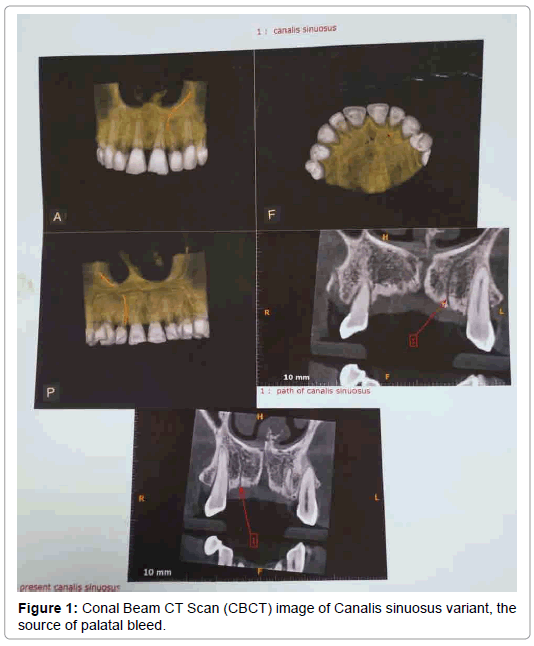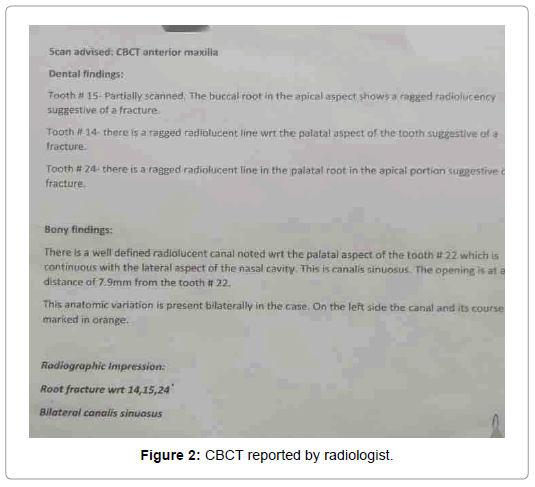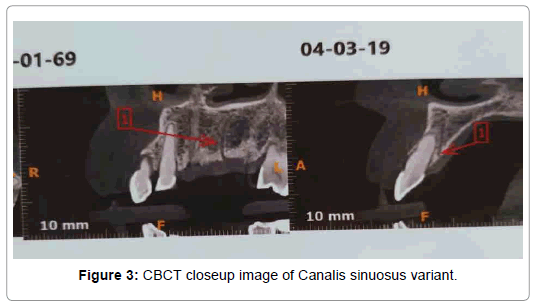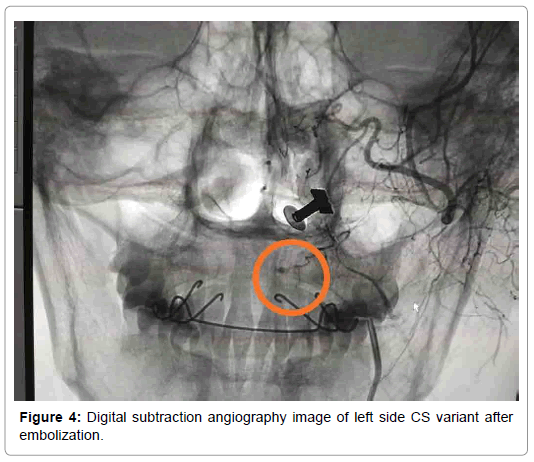Spontaneous Oral Bleeding from Canalis Sinuosus Variant: A Case Report
Received: 27-Sep-2019 / Accepted Date: 12-Nov-2019 / Published Date: 19-Nov-2019 DOI: 10.4172/2161-119X.1000384
Abstract
We report a case of spontaneous bleeding from canalis sinuosus variant presenting as profuse oral bleed. Conal Beam CT Scan (CBCT) was done to confirm the anatomical variant and the bleeding was controlled using Digital Subtraction Angiography (DSA) and injection of glue. It is probably the first reported case of spontaneous active bleeding from a rare variant of Canalis Sinuosus (CS) opening in the hard palate.
Keywords: Canalis sinuosus; Oral bleed; Angiography
Introduction
Canalis Sinuosus (CS) is a bony canal for Anterior Superior Alveolar (ASA) nerve and corresponding vessels. Variants of this canal are infrequently reported and can have significant clinical implications. We encountered one such case which presented with oral bleed and was managed successfully.
Case Report
A 38 year old lady presented with continuous fresh bleed from oral cavity for last 2 months. Bleeding was spontaneous in onset with no history of iatrogenic or accidental trauma. No history of any comorbidities with normal general physical examination. On clinical head and neck examination, there was a well demarcated bleeding site from left side hard palate in paramedian location which was relieved by local pressure. The mucosa around the bleeding point was unremarkable. There were no associated comorbidities or bleeding diatheses. Routine blood tests and coagulation profile was normal. She had been given a palatal obturator for pressure tamponade by the local dentist for temporary control of bleeding (Video 1).
Video 1
A Conal Beam CT Scan (CBCT) (Figure 1) was done which revealed a rare canalis sinuosus variant which was the origin of bleeding. CBCT was reported as a well defined radioluscent canal with respect to palatal aspect of tooth #22 continuous with lateral aspect of nasal cavity. Canal is opening at a distance of 7.9 mm from tooth #22 (Figures 2 and 3).
Treatment options were considered to stop the continuous flow of blood. We discussed the case with our interventional radiology colleagues to ascertain the possibility of occluding the vessel and the canal using Digital Subtraction Angiography (DSA) (Figure 4). Patient was counselled and planned as a day care procedure.
The vessel/canal was occluded using histoacryl glue (33% lipoidal mixture) and bleeding stopped on table. Till the time of this case report, it has been 2 months and there has been no recurrence of bleeding from the site.
Discussion
CS is a bony canal which carries the neurovascular bundle to supply the premaxilla in the canine and incisor region. It emerges as a small bony canal from the lateral aspect of infraorbital canal, close to its midpoint, running forward and downward to the inferior wall of the orbit, lateral to the infraorbital canal and bends medially to the anterior wall of the maxillary sinus, follows the lower margin of the nasal aperture, and opens next to the nasal septum in front of the incisive canal [1]. CS contains the Anterior Superior Alveolar (ASA) nerve and corresponding vessels. It is named so due to its double curvature course.
Frederic wood jones was the first who described an accessory bony canal carrying ASA nerve and vessels [2].
Neurovascular bundles in the anterior maxilla can have certain practical considerations. First, a dental implant inadvertently impinging on the neurovascular bundles can cause non integration of implant or post operative pain. Secondly, there is a risk of misinterpretation of such structures with other anatomical structures especially on plain radiograms leading to diagnostic confusion and unnecessary procedures. Third, intraoperative complications like haemorrhage can result due to non identification of such structures. Therefore, the preoperative identification of the course of nerves and vessels through radiographic evaluation is essential for safe surgical procedures.
The importance of such variations is most important in dental implants, in which the contact with neurovascular bundle of CS may compromise osseointegration and cause temporary or permanent paresthesia with haemorrhage [3]. The American Academy of Oral and Maxillofacial Radiology (AAOMR) in recent recommendations has suggested CBCT as the best option in preoperative diagnosis for implants [4]. However cost and availability are a concern for routine CBCT.
Since these neurovascular canals appear as hypodensities on CT scan, the exit profile and orientation of the accessory canal can lead to a circular radiolucency superimposed on the root of normal teeth on Intraoral periapical Xray (IOPA). It can mimick the apical resorptive defect with relation to a tooth. A misdiagnosis in this case can lead to unnecessary surgical intervention of the tooth [5].
Although CS can be identified on IOPA, it is difficult to locate it on conventional radiography. This could be due to small diameter of the canal, porous cortical layers, and variable course. CBCT is advantageous in such cases as it clearly delineates the CS and any abnormal variations [6].
Machado et al. found accessory canals of the CS by CBCT in 51.7% of their 1000 patients [7]. The research emphasises the importance of this anatomical variation to the operating surgeon to prevent iatrogenic injuries.
Conclusion
Canalis sinuosus can have rare anatomical variants posing clinical challenges which should be kept in mind. CBCT is recommended to diagnose a possible CS and its accessory canals, diameter, length, variations to voiding possible iatrogenic disorders and to locate any bleeding site related to maxillary region. Finally DSA can be used to locate and stop bleeding from accessory/abnormal neurovascular bundles in the maxillary region.
Conflict of Interest
The author declares no conflicts of interest during the course of the making of this paper.
References
- Wanzeler AM, Marinho CG, Alves Junior SM, Manzi FR, Tuji FM (2015) Anatomical study of the canalis sinuosus in 100 cone beam computed tomography examinations. Oral Maxillofac Surg 19: 49-53.
- Jones FW (1939) The anterior superior alveolar nerve and vessels. J Anat 73: 583-591.
- Arruda JA, Silva P, Silva L, Zavanelli R, Rodrigues C et al. (2017) Dental Implant in the Canalis Sinuosus: A Case Report and Review of the Literature. Case Rep Dent 2017: 4810123.
- Tyndall DA, Price JB, Tetradis S, Ganz SD, Hildebolt C, et al. (2012) Position statement of the American Academy of Oral and Maxillofacial Radiology on selection criteria for the use of radiology in dental implantology with emphasis on cone beam computed tomography. Oral Surg Oral Med Oral Pathol Oral Radiol 113: 817–826.
- Shah PN, Arora AV, Kapoor SV (2017) Accessory branch of canalis sinuosus mimicking external root resorption: A diagnostic dilemma. J Conserv Dent 20: 479-481.
- von Arx T, Lozanoff S, Sendi P, Bornstein MM (2013) Assessment of bone channels other than the nasopalatine canal in the anterior maxilla using limited cone beam computed tomography. Surg Radiol Anat 35: 783-790.
- Machado VDC, Chrcanovic BR, Felippe MB, Manhães Júnior LRC, de Carvalho PSP (2016) Assessment of accessory canals of the canalissinuosus: a study of 1000 cone beam computed tomography examinations. Int J Oral Maxillofac Surg 45: 1586–1591.
Citation: Bhardwaj V, Chauhan CPS, Jain A (2019) Spontaneous Oral Bleeding from Canalis Sinuosus Variant: A Case Report. Otolaryngol (Sunnyvale) 9: 384. DOI: 10.4172/2161-119X.1000384
Copyright: © 2019 Bhardwaj V, et al. This is an open-access article distributed under the terms of the Creative Commons Attribution License, which permits unrestricted use, distribution, and reproduction in any medium, provided the original author and source are credited.
Select your language of interest to view the total content in your interested language
Share This Article
Recommended Journals
Open Access Journals
Article Tools
Article Usage
- Total views: 4230
- [From(publication date): 0-2019 - Dec 19, 2025]
- Breakdown by view type
- HTML page views: 3287
- PDF downloads: 943




